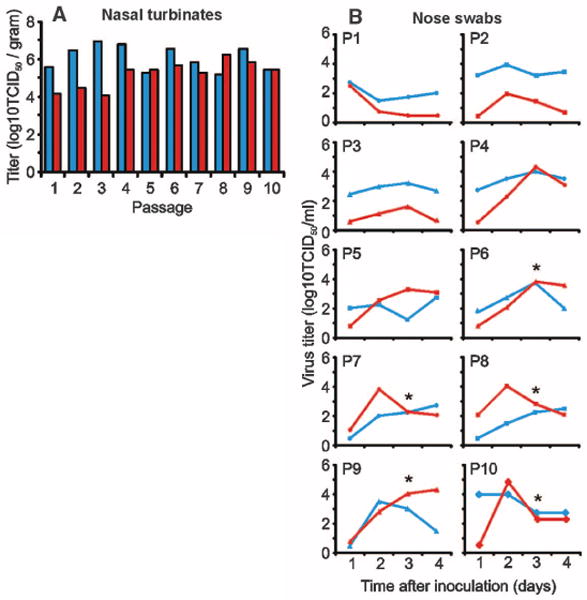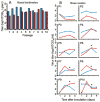
| PMC full text: | Science. Author manuscript; available in PMC 2016 Mar 29. Published in final edited form as: Science. 2012 Jun 22; 336(6088): 1534–1541. doi: 10.1126/science.1213362 |
Fig. 3

Virus titers in (A) the nasal turbinates collected at day 4 and (B) nose swabs collected daily until day 4, from ferrets inoculated with A/H5N1wildtype (blue) and A/H5N1HAQ222L,G224S PB2 E627K (red) throughout the 10 serial passages described in Fig. 2. Virus titers were determined by end-point titration in MDCK cells. After inoculation with A/H5N1wildtype, virus titers in the nasal turbinates were variable but high, ranging from 1.6 × 105 to 7.9 × 106 TCID50/gram tissue (A), with no further increase observed with repeated passage. After inoculation with A/H5N1HA Q222L,G224S PB2 E627K, virus titers in nasal turbinates averaged 1.6 × 104 in the first three passages, 2.5 × 105 in passages four to seven, and 6.3 × 105 TCID50/gram tissue in the last three passages, suggestive of improved replication and virus adaptation. A similar pattern of adaptation was observed in the virus titers in the nose swabs of animals inoculated with A/H5N1HA Q222L,G224S PB2 E627K (B). These titers also increased during the successive passages, with peak virus shedding of 1 × 105 TCID50 at 2 dpi after 10 passages. Altogether, these data indicate that A/H5N1HA Q222L,G224S PB2 E627K adapted to more efficient replication in the ferret URT upon repeated passage, with evidence for such adaptation by passage number 4. In contrast, analyses of the virus titers in the nose swabs of the ferrets collected at 1 to 4 dpi throughout the 10 serial passages with A/H5N1wildtype revealed no changes in patterns of virus shedding. Asterisks indicate that a nose wash was collected before the nose swab was taken, which may influence the virus titer that was detected.





